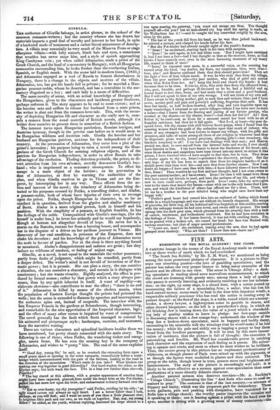FINE ARTS.
EXHIBITION OF THE ROYAL ACADEMY: THE CLOSE.
A PARTING lounge in the rooms of the Royal Academy made us remember two or three works of merit which we had overlooked.
"The South Sea Bubble," by Mr. E. M. Ward, we mentioned as being among the most prominent pictures of character. It is a picture to illus- trate one absorbing passion—the love of gambling speculation; and the painter has taken the very proper licence to bring many examples of the passion and its effects in one view. The scene is 'Change Alley: a dash- ing speculator is reading aloud some marvellous announcement, to which the crowd are listening with greedy ears; among them a lady of quality who passes is covertly listening, and evidently resolving to use her informa- tion: on the right, up some steps, is a closed door, with a notice posted up announcing the failure of a speculating firm; a sailor, who has lost his bard-earned money, seems ready to beat in the door with impotent wrath; a respectable military pensioner who has read the notice is coming away in patient despair: at the footof the steps, is a table, round which are amoney- lender, a showy lawyer, a highwayman come to gamble in shares, and other shrewd bargainers: on the left is a pawnbroker's shop, in which an old blinking Jew is beating down the value of a jewel which a sharehold- ing lady of quality wishes to leave in pledge: her foot-page outside is discussing shares with a Jew orange-boy: underneath the window of the shop lies a broken-down speculator, sunk in beggary and bodily decay, recounting to his miserable wife the winnings that he would make if he had the money; while his pale and sickly son is begging a penny to bay them bread from the heedless passengers. It will be seen by this mere enume- ration of incidents, that the picture is full of thought: the execution is painstaking and forcible. Mr. Ward has considerable power in catching both character and the expression of each feeling as it passes. His colour- ing is opaque and crude, and most so where he most wishes to be brilliant,. Thus, the centre group in this picture has an unpleasant predominancy of whiteness, as though plaster of Paris were mixed up with the pigments, or as though the figures were modelled in plaster and then coloured. The group at the table, though lower in tone, possess more real brightness and luminousness. The story of the picture is exceedingly well told: it rs likely to be more effective as a sermon against over-speculation than some productions of a more directly didactic character.
Another painted sermon also deserves mention--Mr. A. Rai:Lido-1i "Village Church"; illustrating the line "And fools who came to scoff re- mained to pray." The costume is that of the last century,—a mixture of frippery and laxity, which was the properest garb for debauchery. Three town gallants, pale and peaking with dissipation, have wandered for a frolic into a village church; the worthy pastor improves the occasion and is speaking at them: one is leaning against a pillar, with his hand over his eyes; another is sitting with a growing sense of uneasy conscienc—the more uneasy because the third, whose casehardened conscience is sermon- proof, is still whispering scoffs of the religious discourse. This is a picture that should be appropriated by Bible Societies: it is seldom that designs with a set moral of the kind are so perfectly intelligible, or animated by so much real ability.
A third work which we should not wish altogether to pass is Mr. H. Le Jenne's "Liberation of Slaves "; not a scene for 1847, but the Scriptural liberation of slaves, from Exodus and Deuteronomy. The picture is hung somewhat high for the size of the figures, and we could not venture on minute criticism; but the composition is symmetrical, and the treatment appears to be pleasing and graceful in no common degree.
Repeated visits to the collection which has just- closed, have confirmed our opinion, that it has been one of the most interesting from its variety and promising from its individuality of any that we remember. Each ar- tist has seemed more decidedly intent on working out what is in him, with- out so much of the old superstitious veneration for particular "walks," or so servilely copying some prototypes. Thus, Mr. Ward paints aggregated pictures of character-as Hogarth did; but there is neither servility nor presumption in the following: he paints such pictures because it is a na- tural bent with him; and hedoes not at all attempt to copy Hogarth's man- ner, but, with excellent sense, goes direct to his object in the best manner that-is is pertinent to himself. So Mr. Frith develops a very delicate and powerful apprehension of human nature in its social aspect. So Edwin Landseer paints animals, not as Snyders saw them-which was in rather a spiky, wiry guise-but RE he, Landseer, sees them. So Sidney Cooper and many landscape-painters give us admirable because genuine versions of na- ture in different aspects. It is precisely in the "highest walks" that lack of originality, imagination, and power, is most apparent. The chief ex- ception is Mr. Herbert's picture, which departs from the routine of pictorial authority.
In the Sculpture Room there is scarcely an exception to the cold man- nerism of stale imitations. Our sculptors have not attained the Promethean fire of genius that makes the marble live: they work to pattern, like the degenerate Greek painters of the middle ages.



























 Previous page
Previous page